
Re-Learning Curves: The Making of Electrikhana
Ken Block is questioning whether he’s going to pass out. It had taken just a moment from the point he pulled the handbrake for the wheel speed of his Audi Hoonitron S1 to go from 93 mph to 5 mph. He expertly timed turning the wheel to the right and released the brake while mashing the throttle. Without grip, wheel speed climbed faster than it fell, and in a heartbeat the Audi’s four Toyo Tires were spinning past 100 mph.
Now in the center of the cyclone, the pace at which Ken is spinning is surprisingly fast. The lights of Las Vegas begin to flatten into motion blurred horizontal stripes across his windshield as the cabin fills with tire smoke. Centrifugal forces pull at Ken’s hands as expected, and he levels wheel speed out, 115 mph glowing eerily through the smoke from the speedometer. That’s when the tunnel vision starts to set in.
The trick Block has been asked to perform in the making of the final scene of Hoonigan’s first-ever Electrikhana film is called a center axis donut, though its nickname is a “cyclone.” While the art of making donuts in a rear-wheel drive car is all about pivoting around the front wheels, physics are a bit different in an all-wheel drive car. Once the donut is initiated, the all-wheel drive car rotates on its center axis making for a much tighter radius, effectively spinning in place. It’s how they manage a tight and fast rotation in a casino lobby without using the electric drivetrain to spin the wheels in opposite directions to simulate a tank turn.

Cyclones are just one trick in Ken Block’s bag when filming a Gymkhana film, and also a go-to for the all-wheel drive cars Block tends to prefer. However, the reported weight of the 3,700 lb. Hoonitron and its batteries combined with big power from two of Audi Sport’s MGU05 electric motor units and their intensely immediate torque, Ken and the Gymkhana team find themselves on a whole new learning curve.
The story was much the same for Audi Sport in Formula E just a few years before. It had taken several seasons for the open-wheel EV series to evolve from tightly controlled components to adoption of more significant manufacturer developed tech. Audi bided their time during those early seasons, learning what they could. Once Formula E did open up the rulebook, Ingolstadt immediately set its engineers on the task and introduced the MGU05 ahead of the 2021 season. Audi took far less time, just one racing season, to decide to move on to other forms of racing. Even still, what had been developed in the MGU05 was not a wasted effort by any stretch, because there are two of them in the Hoonitron and three more in each of RS Q e-trons participating in the Dakar Rally (pp. 30-31).
Each MGU motor produces 250 kW (335.25 hp) and 320 Nm (236 lb-ft) of torque. The MGU05 is capable of reaching speeds of 28,000 rpm, so the Audi Sport development team defined a gear ratio of 12:1 for the Hoonitron’s single speed transmission. Calculating for drivetrain losses, the result is a reported 2,212 lb-ft. per axle or 4,424 lb-ft. total.

The S1 Hoonitron was also a quickly developed project. This first-ever electric gymkhana car went from idea to hooning reality in just eight months. Audi Sport reportedly reassigned much of the DTM engineering team over to the project, while the Audi Design team including Marc Lichte himself got involved in creating a modern forward-looking form that still greatly harkened the much-loved Audi S1 E2 Pike’s Peak racer of 1987.
The result is a small low-slung coupe with 52:48 weight distribution and 94.4-inch wheelbase that is longer than a 1984 S1 Sport quattro, shorter than a 2023 S1 Sportback and optimum for yaw moments like center axis donuts, the maneuver making Ken Block question whether he’ll pass out.
The pace and significance of the paradigm shift as it pertains to electrics is an underlying theme across the automotive industry. Filming viral stunt videos like the Gymkhana series is just one manifestation of the challenge, though the stakes on the Las Vegas set of Electrikhana 1 are incredibly high. Ken Block and his partner Brian Scotto shared on a recent YouTube video an estimation that the Hoonitron cost Audi about 12 million dollars to build. They caught flak for it, critics suggesting it was an exaggeration. Even still, Scotto pushes back on the notion. Consider development hours involved, from the team of engineers, designers at the highest level, exotic components like the already developed MGU05 or yet-to-be developed mundane yet expensive production-quality laser headlights for a car that didn’t exist. Yes, Audi has built plenty of concept cars before, but they’ve never jumped them off of parking garage deck ramps much less slide them backwards at license-revoking speeds down the Las Vegas strip.

Ken Block reportedly wasn’t afraid of wrecking a 12-million-dollar car. However, time hadn’t afforded him nor his team much of a chance to get acquainted with the tech either. What they were very quickly learning on the neon-lit streets of Las Vegas was that some of those tricks in Ken’s bag, perfected as they were over 14 years of Gymkhana films in any number of internal combustion engine (ICE) gymkhana cars, all needed a serious rethink.
The single gear nature of the S1 Hoonitron didn’t allow for shifting down to adjust drivetrain drag on the wheels. There’s no clutch and no multi-gear transmission, no link to the front and rear via mechanical differential. Instead, it’s two Formula E motors connected by software.
And while Audi Sport has plenty of telemetry data and learning they could share from numerous years in Le Mans and even the more recent Dakar program, much of that doesn’t really apply here. In the world of gymkhana, you’re trying to make the car do things it’s not really supposed to do.
So, consider the challenge for engineers designing the artificial center differential to the car, an element that is paramount to controlling the car in a slide. They had little to no data to build off of. They’re experts in setting fast lap times in Le Mans or outlasting the elements in moonscapes such as the Dakar rally, but gymkhana is a whole different world of automotive physics. They might understand rally but even there, a gymkhana car has two to four times the power and is pushed to eleven by not just sliding sideways but also backwards. Tricks Ken Block performs in filming are maneuvers you’d likely never try in rally because they’re far too risky when trying to make time and preserve the car over a staged race. For Block and the engineering team, it’s far less about those incredible Formula E motors and far more about how you put power to the ground.

Tricks that got thrown out were ones that favored the multi-gear setup of ICE gymkhana cars. Things like tight, small and technical maneuvers were out. You won’t see longtime gymkhana go-tos in Electrikhana 1, things like donut boxes and figure eights.
Instead, they focused on what the Hoonitron favored. The S1’s willingness to provide immediate and spectacular torque allowed them to do big, high-commitment, high-speed slides. They leaned more into things like reverse entry turns or 360-degree slides. And while they’d done these before, the lack of gearbox and instant wheel speed allowed them to do this on a whole other level. Whereas Ken would perform some of these maneuvers entering at 50 mph in the past, the intensity of the Hoonitron’s drivetrain had him now doing it at 100+ mph.
The first major trick of Electrikhana is a reverse entry slide around the “Welcome to Las Vegas” sign at the entrance to the Las Vegas Strip. In this sort of slide, you overrotate the car so that it flips 180-degrees and is physically traveling backwards though the wheels are still spinning forwards as they claw to change the direction of the car. It’s a cinematically impressive maneuver they’ve done before in Gymkhana 1, then bigger in Gymkhana 7 and 10… and maybe even a signature Ken Block trick at this point. In the Hoonitron with immediate torque and unencumbered by a gearbox, the level of violence and pure energy that results would not have been possible with a sequential transmission. Shifting down would have slowed the wheel speed too much. This time, Block just needs to mash the throttle and wheel speed immediately goes to 120 mph.

360-degree slides where you induce a full rotation at speed are also at a whole new level with the Hoonitron’s electric drivetrain. Here again, they were a go-to before, but use of a multi-gear transmission was limiting. In the past, you’d have scrubbed off much of the speed and Ken needed to shift to second or even first by 270-degrees in order to pull the car out of the rotation in a way that looked dramatic or as fast as he’d entered it. In the Hoonitron and at 270-degrees rotation, Ken is back on the throttle and pulling himself out seamlessly.
What resulted was the second big stunt of the film. Ken executes the spin while traveling at incredibly high speed down Las Vegas Boulevard, a.k.a. “The Strip”. You have to wonder if it’s one of Hoonigan’s famed easter eggs (like the Wackel Elvis on the Hoonitron’s dashboard) as Block seems to fake a turn into the Arco gas station at the intersection of Reno Drive. It’s probably not intended since he’s moving way too fast for it to be an intentional tease, with the drone tight enough on the car that you don’t even really know it’s a gas station unless you’re a local. Even still, it’s the sort of swagger that Ken Block and his team are known for.
That seemingly faked turn is just the beginning of the 360-degree rotation of the fast-moving electric Audi. By the time Ken’s crossing the intersection, he’s already at 180-degrees and traveling backwards across Reno Drive. Just past the pedestrian crosswalk on the far side, he’s straightened out and back on throttle in spectacular fashion. In the past, the team has avoided big and fast 360s like this, because they just don’t look smooth. With an electric gymkhana car like the S1 Hoonitron though, Ken Block has demonstrated that they are now most definitely possible.
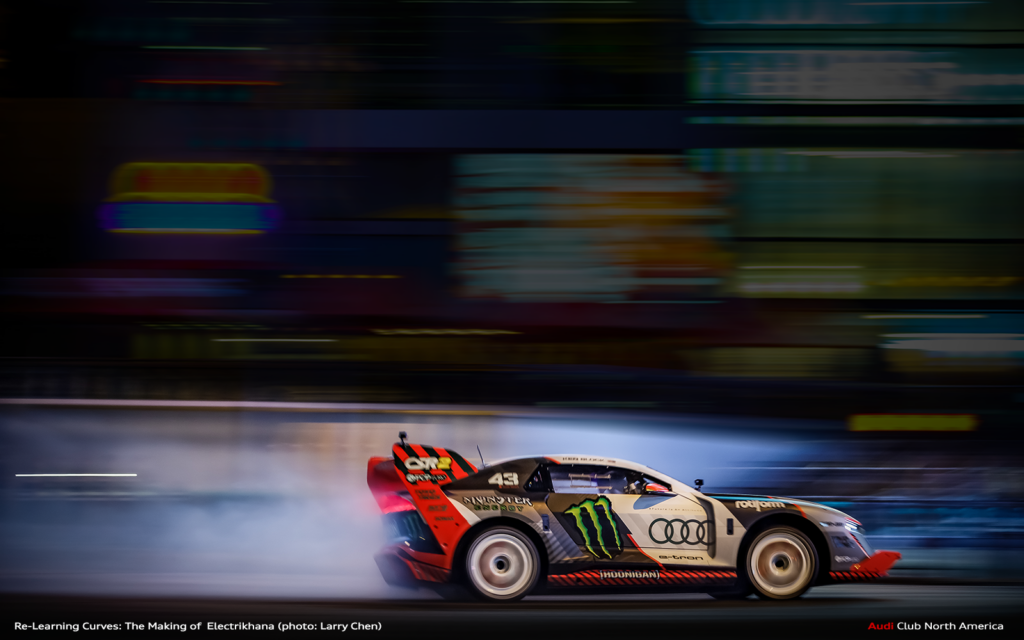
Of course, in the last month since it dropped, 5.19 million of us watched the ending on YouTube. Ken Block didn’t pass out, though he may have immediately radioed the team telling them he hoped they got the shot because his stomach didn’t particularly want to let him try it again.
In the meantime, Block’s team has already returned from filming of Electrikhana 2. Though they’re coy about details, they say they’ve learned a lot and managed to push the envelope considerably further with the car. Audi Sport engineers were also able to provide the control of a multi-gear transmission by programming stepped torque loads to simulate downshifts that will give Block even more control over the physics of the S1 Hoonitron. Several tricks attempted in Vegas are now possible to pull off in smooth enough fashion to make the cut, while other untried and formerly impossible maneuvers were also integrated. In as much, they’ve embraced the electric paradigm shift, and coincidentally with no gears to shift at all.
Watch Electrikhana here.
Editor’s Note: This story originally ran in quattro Magazine issue Q1_2023. Original exclusive features like this and a subscription to quattro Magazine are key benefits of membership in Audi Club North America. If you enjoyed this feature, please consider joining Audi Club North America HERE.
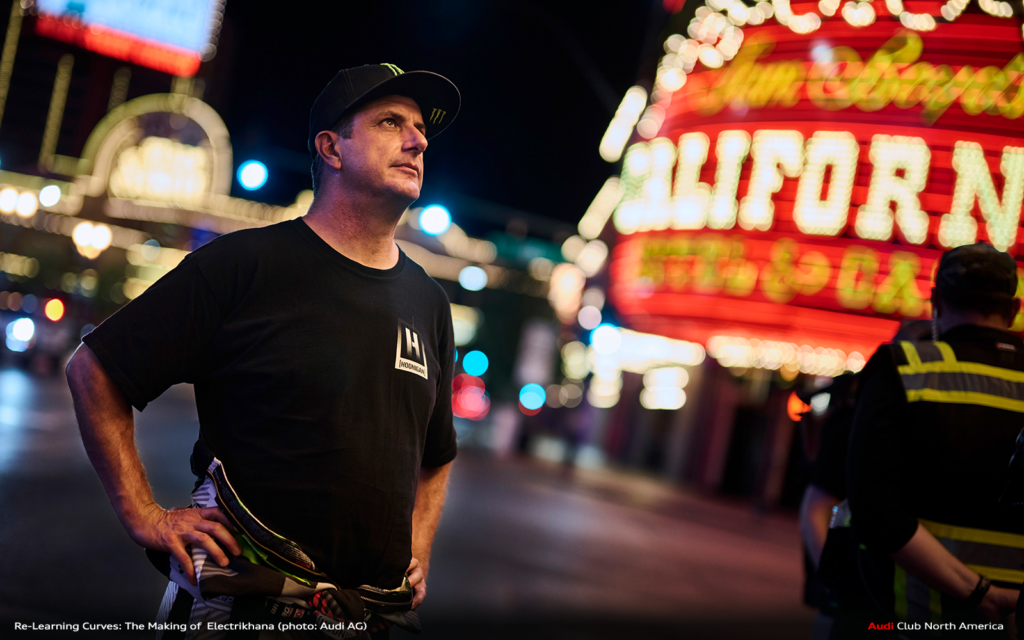



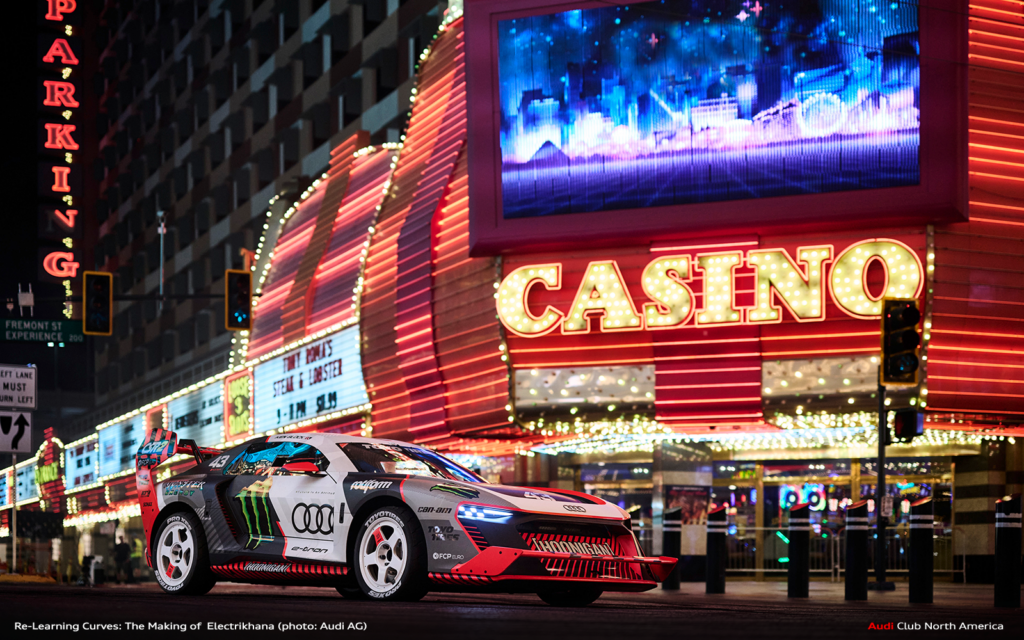
















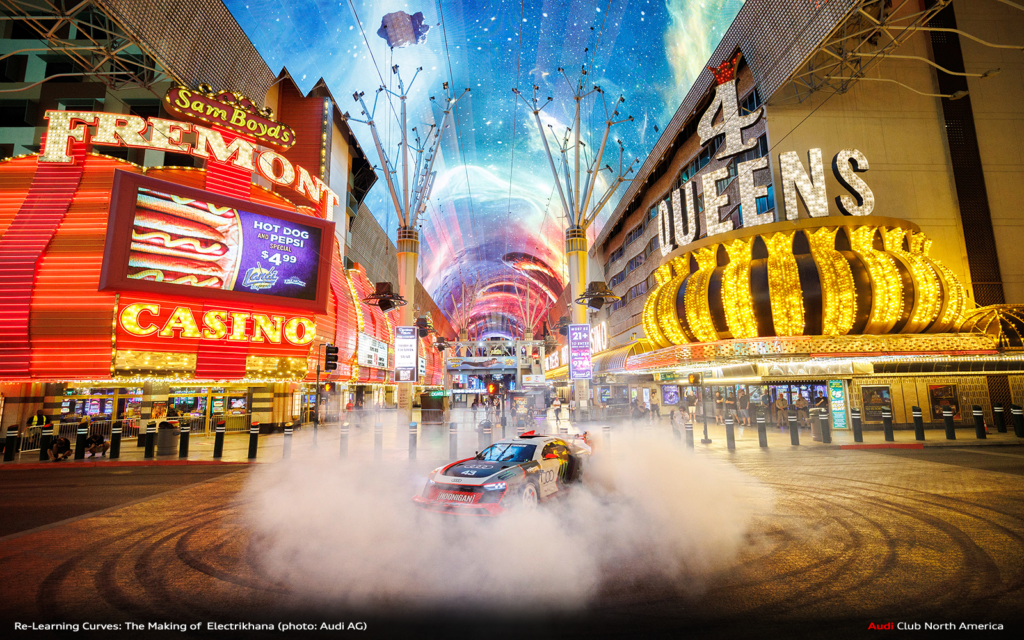
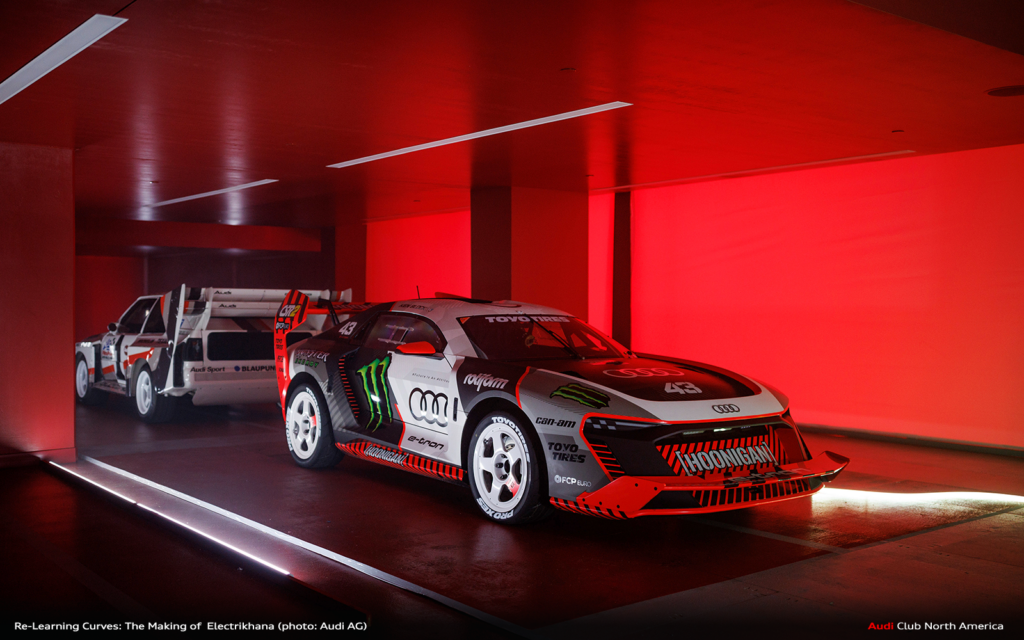
















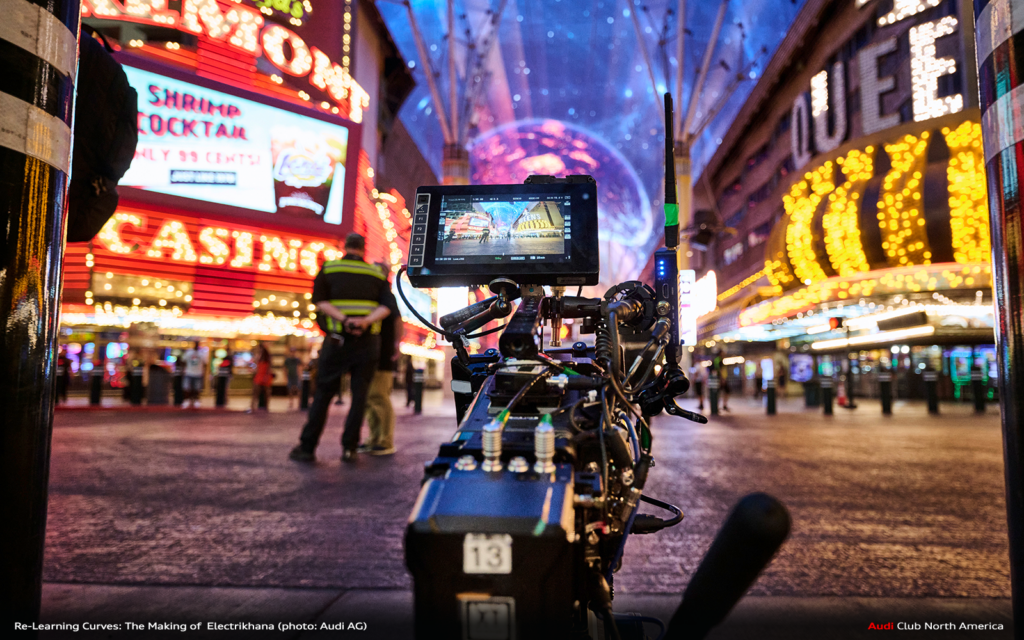










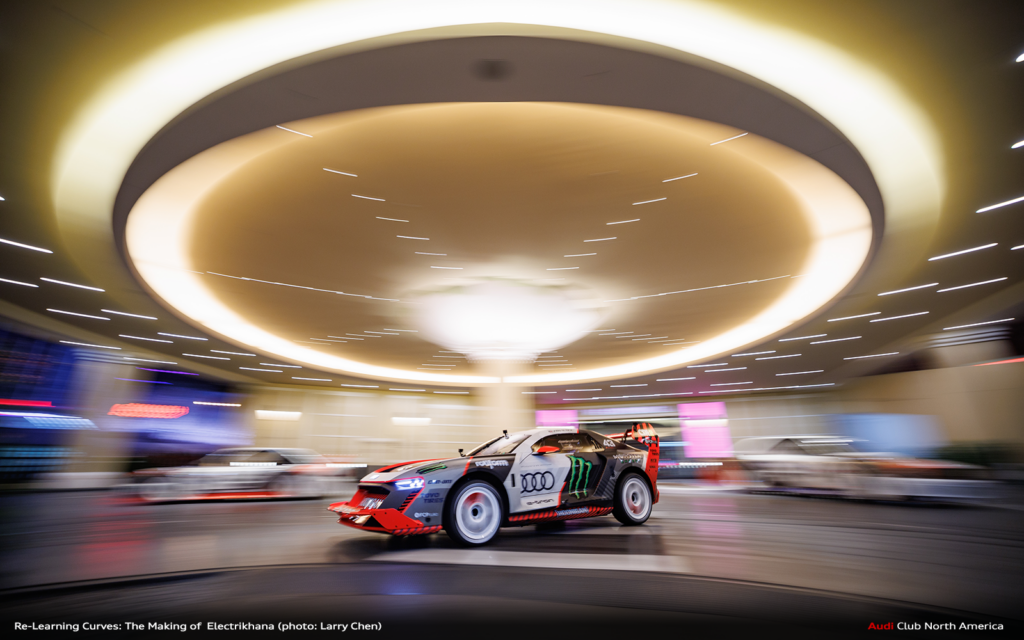











Responses